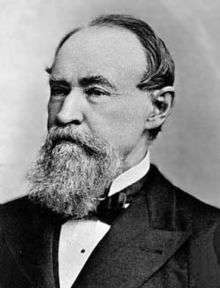William Ferrel
William Ferrel (January 29, 1817 – September 18, 1891), an American meteorologist, developed theories which explained the mid-latitude atmospheric circulation cell in detail, and it is after him that the Ferrel cell is named.
| William Ferrel | |
|---|---|
 | |
| Born | January 29, 1817 Fulton County (United States) |
| Died | September 18, 1891 Wyandotte County (United States) |
| Occupation | |
Biography
Ferrel was born in Fulton county in southern Pennsylvania.[1] His family moved to what would become West Virginia in 1829. His formal elementary schooling was limited and he taught himself using science books well enough to become a school teacher. He attended Marshall College[2] and despite financial difficulties, he was able to graduate from Bethany College's first graduating class in 1844. He would continue teaching in Missouri and Tennessee until 1858. At that point, he took up a full-time position on the staff of American Ephemeris and Nautical Almanac in Cambridge, Massachusetts.
In 1882, Ferrel joined the U.S. Army Signal Service (which would become the Weather Bureau in 1891) and retired in 1886. He died in Maywood (Wyandotte county), a suburb of Kansas City, in 1891.[1]
Work
Ferrel demonstrated that it is the tendency of rising warm air, as it rotates due to the Coriolis effect, to pull in air from more equatorial, warmer regions and transport it poleward. It is this rotation which creates the complex curvatures in the frontal systems separating the cooler Arctic/Antarctic air polewards from the warmer tropical air towards the equator.
Ferrel improved upon Hadley's theory by recognizing an until then overlooked mechanism. This is a quote from his first paper:
The fourth and last force arises from the combination of a relative east or west motion of the atmosphere with the rotatory motion of the earth. In consequence of the atmosphere's revolving on a common axis with that of the earth, each particle is impressed with a centrifugal force, which, being resolved into a vertical and a horizontal force, the latter causes it to assume a spheroidal form conforming to the figure of the earth. But, if the rotatory motion of any part of the atmosphere is greater than that of the surface of the earth, or, in other words, if any part of the atmosphere has a relative eastern motion with regard to the earth's surface, this force is increased, and if it has a relative western motion, it is diminished, and this difference gives rise to a disturbing force which prevents the atmosphere being in a state of equilibrium, with a figure conforming to that of the earth's surface, but causes an accumulation of the atmosphere at certain latitudes and a depression at others, and the consequent difference in the pressure of the atmosphere at these latitudes very materially influences its motions.[3]
Hadley's erroneous reasoning had been in terms of a tendency to conserve linear momentum, as air mass travels from north to south or from south to north. Ferrel recognized that in meteorology and oceanography what needs to be taken into account is a tendency, of an air mass that is in motion relative to Earth, to conserve its angular momentum with respect to Earth's Axis.
See also
- Ferrel's law
- Air mass
- George Hadley
References
- "William Ferrel, American meteorologist". Biographies. Encyclopædia Britannica. November 4, 2018. Retrieved November 10, 2018..
- Hockey, Thomas (2009). The Biographical Encyclopedia of Astronomers. Springer Publishing. ISBN 978-0-387-31022-0. Retrieved August 22, 2012.
- Ferrel, W. 'An essay on the winds and the currents of the Oceans', Nashville Journal of Medicine and Surgery, 1856.
- Wikisource: An essay on the winds and the currents of the Oceans
- Original source: An essay on the winds and the currents of the Oceans (PDF-file 1.4 MB, scanned images of entire pages.)
External links
- NOAA biographical info
- MacTutor biography
- William Ferrel set bar for hurricane predictions (Times & Transcript, Moncton NB, Canada, 24 August 2009)
- National Academy of Sciences Biographical Memoir